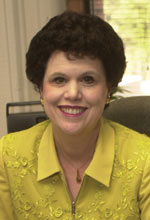Hispanic students perform better in colleges with larger Hispanic communities, UF study finds
Sources
Linda Serra Hagedorn, University of Florida College of Education
(352) 226-1726
GAINESVILLE, Fla. — Hispanic students at community colleges with large Hispanic populations are more likely to earn higher grades and complete their courses, according to a study headed by a professor at the University of Florida’s College of Education.
Educators have long believed that a “critical mass” of like students is vital to making minority students feel at home on college campuses – but this study, appearing in the February issue of the journal Research in Higher Education, may be the first to find statistical evidence to confirm that belief.

Hagedorn
“These data suggest that if colleges are really serious about reaching out to minority groups, they need to think in terms of clusters, not individuals,” said professor Linda Serra Hagedorn, chairwoman of UF’s Department of Educational Administration and Policy. “If you’re the only Latino or African American on your college campus, you can certainly succeed academically – but if you’re surrounded by people who share your cultural background, your chances of success improve.”
Hagedorn is the lead investigator and director of the Transfer and Retention of Urban Community College Students (or TRUCCS) project, a multiyear, comprehensive study of the educational outcomes of 5,000 community college students at the nine community college campuses in the Los Angeles area. Iinvestigators queried the students on their backgrounds, attitudes and experiences, and compared that data to the students’ transcript records.
When they looked at students who self-identified as Hispanic, the researchers found that students at largely Hispanic community colleges had better educational outcomes than students at colleges where Hispanic students were rare. The differences were small but statistically significant. Age, involvement in campus activities and even ability to speak English were less predictive of Hispanic students’ success.
Researchers have long suspected that the size of a school’s minority population plays a key role in the academic experience of minority students. The education field has even borrowed a term from nuclear physics – “critical mass” – to describe the point at which minority students become plentiful enough to change the campus climate and give a school a more welcoming feel.
The study produced some surprising findings. For instance, while students at colleges with large Hispanic colleges were more likely to stay in school and succeed academically, they were also less likely to enroll in remedial English or math classes.
In schools where Spanish speakers are few, teachers may be more likely to refer students to remedial classes, Hagedorn said. And a large community of bilingual students may help struggling English speakers learn the language without formal intervention.
“Clearly, learning the English language is important if you want to succeed academically in the United States,” Hagedorn said. “However it helps if you can turn to a fellow student and ask a fellow Spanish-speaking student to explain when you don’t understand what the teacher is saying.”
The researchers also found that first-generation immigrants – students born in Mexico and other Spanish-speaking countries – tended to do better in school than students born in the U.S. to immigrant parents.
“One might expect students who grew up in the U.S. to perform better because they understand the social climate better,” Hagedorn said. “But in fact, many immigrant students were in very good schools in Mexico before they moved here – while many students who were born in the U.S. live in impoverished urban communities with substandard school systems.”
Alberto Cabrera, a University of Maryland education professor, co-authored an earlier large-scale study which found that parental involvement was one of the best indicators of academic success among Latino students. Cabrera said Hagedorn’s study sheds new light on his own findings.
“Latino students often rely on their families for social support in school because they do not feel represented among the faculty or students,” Cabrera said. “In light of Linda Hagedorn’s findings, I would hypothesize that a critical mass of Latino students can create a support system that mimics the effect of support from one’s family.” Hagedorn said the study is not meant to suggest that parents and counselors should direct students to largely-Hispanic campuses, or discourage them from going to other campuses. Instead, she said, colleges should keep the effect of critical mass in mind when recruiting new students.
The study also reinforces the benefits of the community college system. Hagedorn notes that among the colleges in the study, every institution with a large Hispanic population was located in a largely Hispanic neighborhood – providing additional social support for students.
“They’re called ‘community’ colleges for a reason,” Hagedorn said. “They’re supposed to serve the community in which they reside, and create a comfortable learning environment for students in that community.”
Writer:
Tim Lockette, (352) 392-0726 ext. 274; lockette@coe.ufl.edu




